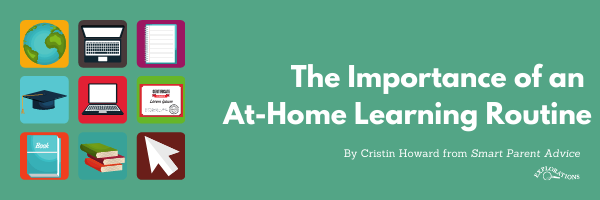
Author Bio: Cristin Howard runs Smart Parent Advice, a site that provides parenting advice for moms and dads. Cristin writes about all of the different ups and downs of parenting, provides solutions to common challenges, and reviews products that parents need to purchase.
Virtual learning still feels like new territory, even after we’ve been doing it for several months.
Kids and parents alike are trying to find their footing and adjust to this new style of school.
If the kids and parents in your house are struggling with at-home school, consider putting together a routine.
Children of all ages (and many adults too!) crave routines and predictability in their days. The benefits of routines for sleep, chores, and other daily activities are numerous, and those same benefits extend to at-home learning.
It is important to develop an at-home learning routine for your kids.
Routines Reduce Power Struggles
Getting your children to do their school work can feel like a constant up-hill battle and leave you with new levels of appreciation for teachers.
While many kids love to learn, they’re not used to parents being the primary instructors. Even children who love school and learning might put up a fight against their parents when it comes to schoolwork.
A routine takes out a lot of the guesswork for both kids and parents. Both sides know the expectations and many questions or fights can be diverted by pointing to the routine and sticking to it.
Self Control
School teaches children more than just subject matter. It’s one of the first places outside the home where children learn to practice self-control. School days are incredibly routine and teach students how to stick to schedules and work within others’ time frames.
An at-home routine will set similar expectations for kids. They will know what to do and when to do it, as opposed to leaving them to follow their whims at all points of the day.
It’s a hard fact of life that sometimes you have to do things you don’t feel like doing, even when you’re an adult. A routine helps kids develop the self-discipline they will need to finish tasks that aren’t their favorite, but still must be done.
Transitions
Any teacher will tell you that transitions are one of the hardest parts of teaching. It’s easy to lose students’ attention when moving from one task to the next. Veteran teachers have many tricks up their sleeves that help classes transition smoothly, but parents don’t have those same years of experience.
Routines take a lot of the guesswork out of transitions. A routine will dictate not only what you are going to do next but will help students think ahead of what they will need for the next task.
Sticking to a schedule and routine means that kids might log off a science Zoom and then immediately move to a quick snack break before it’s time for reading class. The predictability and consistency of routines make them the foundation of an ordered day.
Knowing what is coming next, especially if there is a break or the end of the school day coming soon, will help kids stay on task and motivated.
Parent and Child Happiness
At-home learning is stressful. Very few parents and students would choose this style of school in a normal situation.
Parents already teach their children life skills, make sure they clean their room and complete their chores. Schoolwork adds another facet of things parents must manage. This drains energy and time away from doing more fun and bonding activities with your child.
However, when it’s the best available option, a routine is one of the ways to make it more bearable.
As discussed, routines cut down on power struggles and help develop children’s self-control. They also help children make smooth transitions from one task to the next, without a lot of parent intervention or instruction.
Without the power struggles and constant need to persuade and coax your child to complete their schoolwork, both parents and kids are happier.
Routines and Flexibility
Schedules and routines are intimidating because you never know what is going to happen. Of course, routines are just the framework. They are never set in stone.
As with all things having to do with kids, you have to be able to adapt and change with the situation, so be prepared to allow a degree of flexibility in your routines.
Teachers in a classroom stick to a schedule, but they also know when to change it up. They may read for five more minutes because the children are into the story, or allow an extra recess break when kids are extra antsy.
Take a page out of the experts’ book and adjust your routine as needed, but do your best to keep the same rough schedule as often as possible. While it does take work, in the end, the effort will pay dividends in benefits.
Start Today
Explorations can support your new At-Home Learning routine today with our virtual activities and workshops and our Tailored Learning program.


